Did you know that there are over 300 goat breeds worldwide?
Many of them are already available in the US, but you may be wondering which of them are the exotic goat breeds.
This may sound surprising, but most of the popular goats in the USA are actually exotic.
And we compiled them in this article so you can get more insights into their origin, temperament, and primary uses.
In particular, you’ll discover:
- the Queen of milk who can produce up to 3 gallons daily
- a hardy andaristocratic goat used to upgrade other breeds in tropical countries
- and a bizarre-looking exotic goat monikered asthe bulldog of the goat
If you’re curious about what these goats are, join us as we unveil the list of exotic breeds of goats.
Most Popular Exotic Goat Breeds
So, which goats are most exotic? Here’s a list of different types of exotic goats, starting off with the most popular and prolific dairy breed.
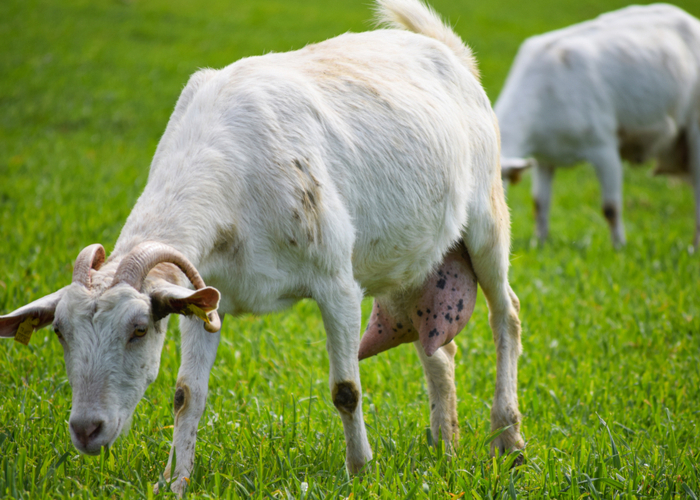
1. Saanen Goat
One of the most popular exotic goat breeds in the world is the Saanen, the “Queen of Milk,” hailing from the native Saanen Valley of Switzerland.
But why are Saanen goats called the Queen of Milk?
Well, this regal breed clothed with a white coat surpasses all dairy breeds in terms of milk production.
Saanen goats can give you up to three gallons of milk with 3 to 5% butterfat content daily.
That amount is thrice the production of Nubians and Toggenburg!
On top of that, their milk comes with anti-oxidative properties that help decrease cholesterol levels and strengthen immunity.
However, their meat is not as tasty as other breeds, making them less desirablemeat goats.
This exotic goat breed has a calm and sweet disposition and is known for being hardy or adaptable to different weather conditions.
In fact, it’s also one of the mostcold hardy goat breeds.
Furthermore, their hooves are strong and disease-resistant, and their legs are long. That’s why they can navigate rough terrains effortlessly.
Due to their prolific milking capacity, minimal cost and space requirements, hardiness, and friendly personality, they’re perfect for small farms and homesteads.
Saanen Goat |
|
Average Height: |
Does: At least 30 inches, Bucks: 32 inches |
Average Weight: |
Does: 135 pounds, Bucks: 170 pounds |
Purpose: |
Milk production |
Temperament: |
Sweet, friendly, and calm |
Colors: |
All white or light cream |
Origin: |
Switzerland |
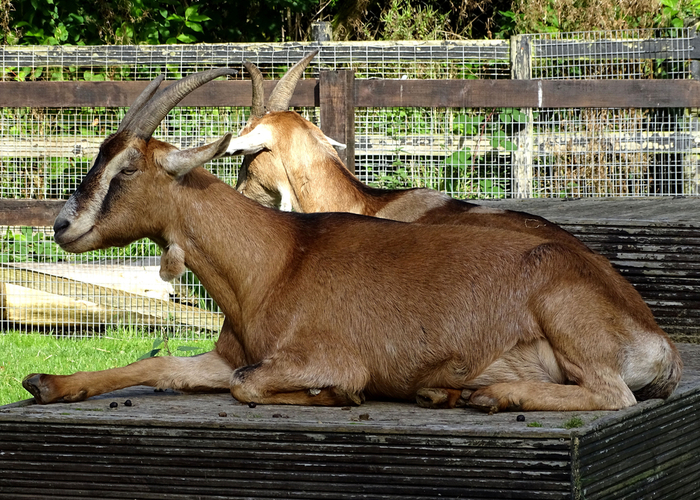
2. Toggenburg Goat
Another exotic goat breed of Swiss origin made it into this list, and just like Saanen, they produce a sufficient amount of milk, ranging from 1 to 3 liters daily.
ButToggenburg goat’sbutterfat content is around 3 to 4 percent which is relatively low compared to the former.
Although they can’t have high yields of cheese due to Toggenburg’s low-fat percentage, some producers believe that its milk gives off a strong and distinct flavor that improves the cheese’s character.
This exotic breed of goat for milk is not as heavy and large as other meat goats, but it can produce good carcasses and thrive on a grass-based diet.
Its meat quality is better than Saanen, especially when crossed with another meat goat breed.
This hardy animal can also adapt to any environment, but they need access to a grassy area with ample shade.
Furthermore, they’re gentle and sociable.
In fact, they can even pass as pets and live with other livestock like chickens with no problem.
What’s even more fascinating about Toggenburg goats is that they can learn commands because they’re naturally smart.
吐根堡山羊山羊 |
|
| Average Height: | Does:70 cm |
| Bucks:75 cm | |
| Average Weight: | Does:120 lbs |
| Bucks:154 lbs | |
| Purpose: | Dairy production |
| Temperament: | Gentle |
| Colors: | Light fawn to dark chocolate |
| Origin: | Switzerland |
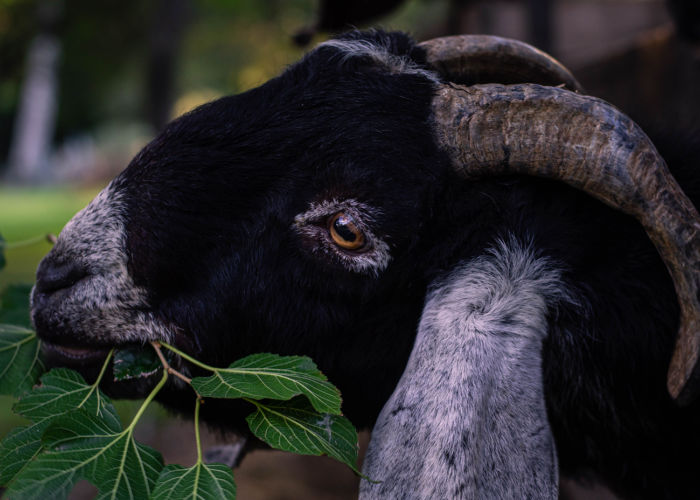
3. Anglo-Nubian Goat
Unlike the previous exotic goat breeds, Anglo-Nubians were developed in Britain, and they’re a cross of African and Indian goats.
This aristocratic goat has a distinct Roman nose, bleat, convex face, and long, pendulous ears.
They’re not as prolific as Saanen and other dairy breeds in the milking department because they can only give 1.2 liters of milk daily over a lactation period of 172 days.
But they offer tasty milk with 4% butterfat content and can also provide a decent amount of meat since they carry more meat than theAlpine goat breed.
This hot hardy goat can withstand high temperatures.
In fact, it can survive Australia’s hot weather conditions.
No wonder it’s used in grading-up programs in different tropical countries to increase their milk and meat production.
Despite being alert, Anglo-Nubians have a mild temperament and respond quickly when shown affection by owners.
This is a multi-purpose breed suitable for meat, milk, and hide production.
Anglo-Nubian Goat Breed Overview |
|
| Average Height: | Does: 80 cm |
| Bucks: 90 cm | |
| Average Weight: | Does: 242 lbs. |
| Bucks: 308 lbs. | |
| Colors: | Red, tan, and black |
| Temperament: | Mild and alert |
| Primary Purpose: | Dairy production |
| Origin: | Britain |
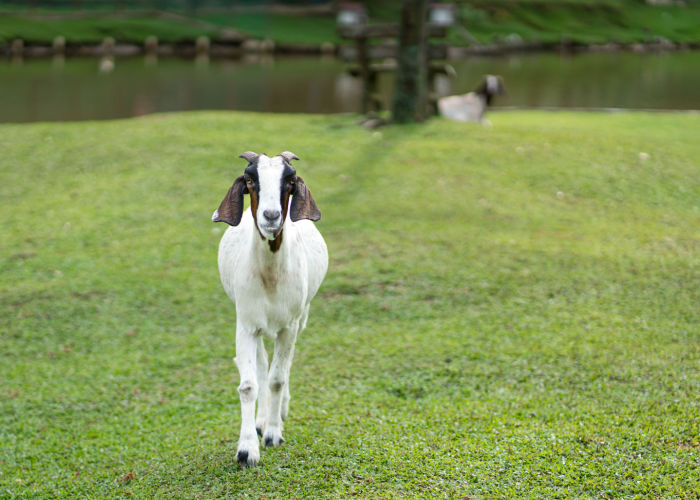
4. Nubian Goat
TheNubian goats创造它的名字from its origin, the Nubia of north-eastern Africa.
It is one of the descendants of Anglo-Nubian goats, and they’re popular in the US for cheesemaking.
This exotic goat is considered dual-purpose because it can provide both dairy and meat.
Their milk has a high butterfat content which is about 5 percent, and it’s only surpassed byNigerian Dwarves, Pygmies, and Boer goats.
That explains why their milk is more flavorful than Saanen and other dairy breeds, and they’re widely used in cheese production.
This breed also has a Roman nose, long ears, and a sleek body.
That’s why they’re often nicknamed “Lop-Eared Goat” or “Greyhound Goat.”
This exotic goat species can survive in hot climates thanks to its Middle-Eastern heritage.
They’re friendly and outgoing, so they can also be your pets.
However, they tend to be vocal, so they’re not ideal for those living in urban areas or in close proximity to other neighbors.
Nubian Goat |
|
| Average Height: | 30 inches |
| Average Weight: | 100 to 250 pounds |
| Purpose: | Dairy and meat production |
| Temperament: | Friendly but noisy |
| Colors: | Black, red, or tan |
| Origin: | Africa |

5. Boer Goat
Despite its wide popularity in the US as a meat goat, Boer is among the exotic goat breeds hailing from South Africa.
But it was infused with Angora, European and Indian breeds in the past.
It’s distinguishable due to its iconic white coat combined with large patches of red/brown on its neck and head and large drooping ears.
Boer goatsare excellent meat producers due to their fast growth rate of 0.4 pounds daily.
It may vary depending on the goat’s feedlot conditions.
But their carcasses are desirable because they have lean and moist meat.
This exotic goat species is also hardy and can adapt well to various environments.
Furthermore, Boer goats are nicknamed the “gentle giants” of the goat world due to their calm and docile disposition.
That’s the reason why they’re also used as companion animals.
They cost around $400 to $500, but their meat is in demand, so raising them for meat is a good opportunity to earn a large profit.
| Boer Goat Breed Overview | |
| Average Height: | Does: 28 inches |
| Bucks: 30 inches | |
| Average Weight: | Does: 190 to 230 pounds |
| Bucks:200 to 340 pounds | |
| Colors: | 白色与红色/棕色的头一个d neck |
| Temperament: | Friendly and docile |
| Primary Purpose: | Meat production |
| Origin: | South Africa |
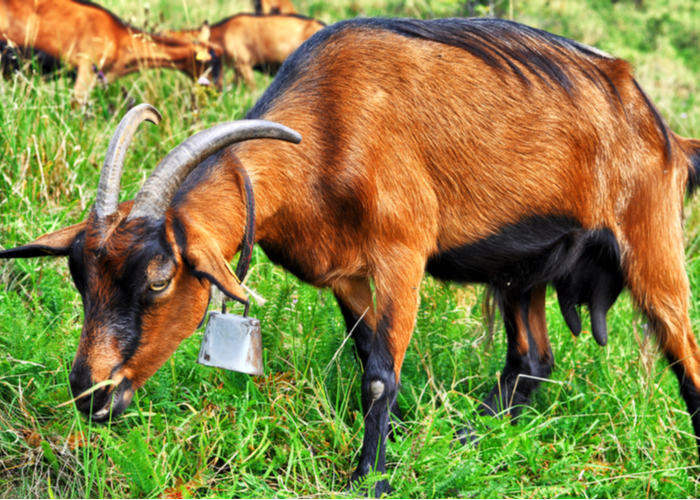
6. Alpine Goat
Another unique and exotic goat breed is the Alpine goat, which originates from Great Britain.
It is one of the oldest yet majestic dual-purpose breeds with a similar body structure to Saanen and the coat markings of Toggenburg.
This large breed weighs 135 to 220 pounds and is around 83 to 95 centimeters tall.
Homesteaders love this breed because they produce tasty meat and easily gain weight.
Furthermore, they are also prolific milk producers that are good for commercial dairies. Why?
It is because, despite the low-fat level of 3.4% of its milk, it’s still sweet because it has higher sugar content than other breeds.
Its milk is sweeter, and this breed can produce up to 1 gallon daily.
Lastly, because of their friendliness, curiosity, intelligence, and pleasant temperament, they are ideal companions to humans.
And because of their ability to balance and adapt to the environment and climate, they are a popular breed, especially for travelers and fishermen.
Alpine Goat |
|
| Average Height: | Does: 83 cm |
| Bucks: 95 cm | |
| Average Weight: | Does: 135 to 155 pounds |
| Bucks: 176 to 220 pounds | |
| Purpose: | Dairy production |
| Temperament: | Friendly, sweet |
| Colors: | White, gray, brown, or black |
| Origin: | French Alps |
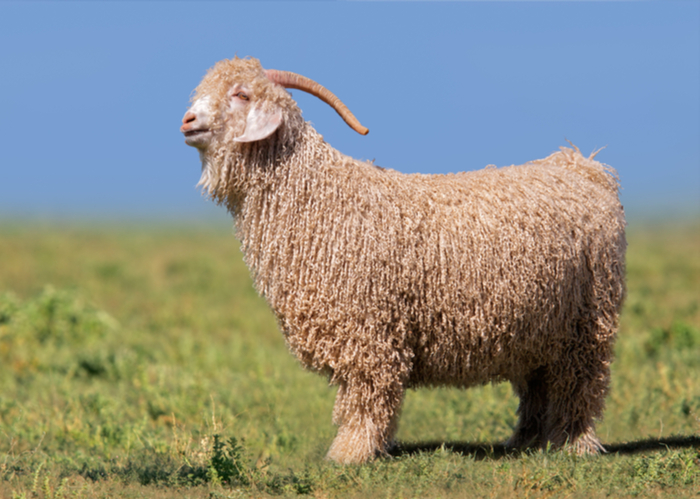
7. Angora Goat
We also can’t forget the magnificent ancient goat breed with long-mohair perfect for mohair and wool production, the Angora.
Its origin is unknown, yet some people say Angora originated in a District in the Himalayan of Asia, while others said it came from Turkey.
The mohair, produced by angora goats, is utilized in the upholstery and clothing industries.
It stands out for its ability to get dyed with vivid colors, hold its shape, shed dirt, and provide a “sheen” to finished products.
Angora goatsare renowned for being exceptionally gentle, calm, and submissive.
These amiable goats are placid and quiet by nature, which makes them vulnerable to predator attacks if they are in a mixed flock.
Andbecause of their distinct, long mohair, they need extra care and more time on grooming.
Angora Goat Breed Overview |
|
| Average Height: | 36 to 48 inches |
| Average Weight: | Does: 100 to 110 pounds |
| Bucks: 180 to 255 pounds | |
| Colors: | White, black, gray, red, and brownish shades |
| Temperament: | Calm, docile, and friendly |
| Primary Purpose: | Mohair production |
| Origin: | Turkey |

8. Jamnapari Goat
Now, we’re down to an exotic goat breed of Indian origin, theJamnapari breed, also called Jamunapari.
It is a dairy goat breed that can give you 2 to 3 liters of milk daily in a lactation period of around 250 days.
Similar to other dairy goat breeds, their milk contains 3.5% butterfat content.
But it can also produce a decent amount of hides and wool since this exotic goat can grow long coats.
This breed is highly adaptable to different climatic conditions and is utilized to upgrade other local goats in India.
Similar to the previous goat, this exotic breed features a Roman nose but is less dramatic than the Damascus’.
Jamnapari is easy to manage, calm, and friendly; thus, it’s easy to care for and ideal for small goat farming.
Its price may vary but typically ranges from $200 to $500 per goat.
Jamnapari Goat Breed Overview |
|
| Average Height: | Does: 29 inches |
| Bucks: 30 inches | |
| Average Weight: | Does: 88 to 130 lbs. |
| Bucks: 140 to 190 lbs. | |
| Colors: | White with tan patches |
| Temperament: | Calm and friendly |
| Primary Purpose: | Milk |
| Origin: | India |
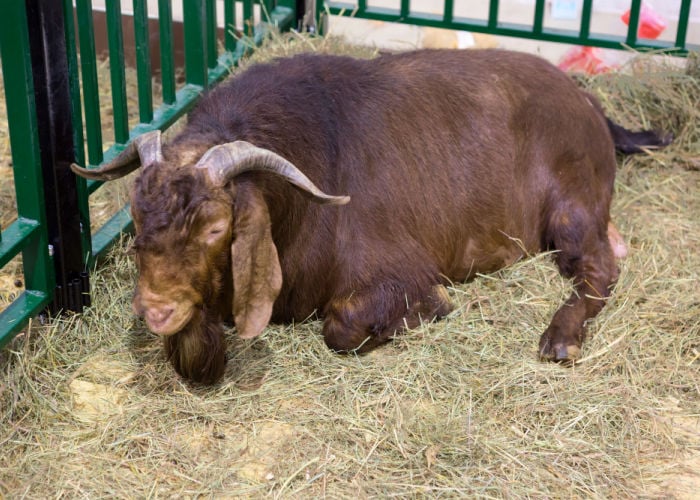
9. Kahalari Reds
We’re finally almost at the conclusion, but it’s worth mentioning theKalahari Red, a goat originating from South Africa, on this list of exotic goat breeds.
These goats were named after the rich red color of the sand in Africa, which the goats used to browse.
Kalahari Red is mainly used for meat production.
Their meat is tender, flavorful, and low in fat, and they are fast-growing and high-yielding.
This exotic goat is calm and gentle and is innately protective of their kids.
Additionally, they’re naturally hardy because they’re well-adapted to different weather conditions in South Africa’s savanna and Kalahari desert.
然而,值得注意的是,像其他breed, when imported or brought to other countries with different weather conditions, they may struggle to adapt to the new environment or management system.
Kahalari Reds Goat Breed Overview |
|
| Average Height: | 30 inches |
| Average Weight: | Does: 165 lbs. |
| Bucks: 250 lbs. | |
| Colors: | Light to dark red-brown |
| Temperament: | Calm and gentle |
| Primary Purpose: | Meat production |
| Origin: | South Africa |
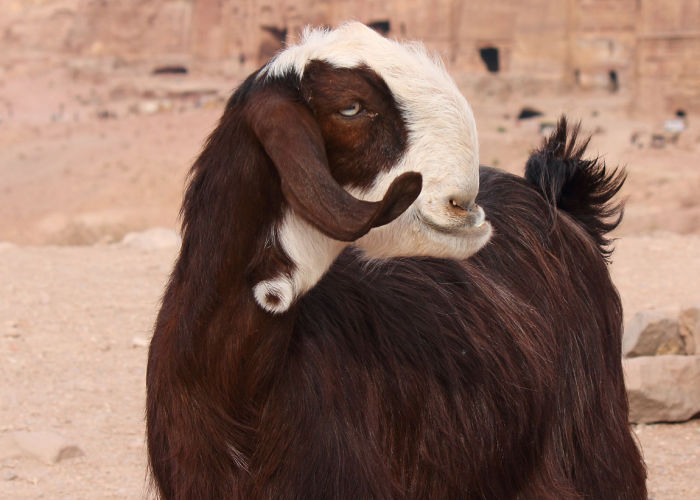
10. Damascus Goat
Since we’re talking about exotic goat breeds, perhaps nothing is more exotic and unique than theDamascus goatdue to its bizarre appearance and large size.
Damascus goat is hailed as the bulldog of the goat world due to its short snout and convex nose.
It looks like it has bumped into a door.
Contrary to the Damascus goat’s strange appearance, well-raised Damascus are friendly and docile.
But sometimes, they can get aggressive due to their innate desire to be dominant over other members of the herd.
This exotic goat can provide you with 350 to 650 kilograms of milk per lactation which lasts up to 200 days.
Its lean meat is also flavorful, making it an excellent meat goat breed.
Others utilize Damascus goat skin in leather and fiber production because their hair is strong and doesn’t break easily.
Since this exotic breed was developed in the Middle East, its innately hardy and can withstand extreme weather temperatures.
But since this goat is rare, they are very expensive, and importing them is challenging.
Damascus Goat Breed Overview |
|
| Average Height: | Does: 70 to 75 cm or 28 to 30 inches |
| Bucks: 80 cm or 31 inches | |
| Average Weight: | Does: 110 to 140 pounds |
| Bucks: 150 to 190 pounds | |
| Colors: | Brown with rare black and white to cream varieties |
| Temperament: | Friendly and docile |
| Primary Purpose: | Meat and milk production |
| Origin: | Syria |
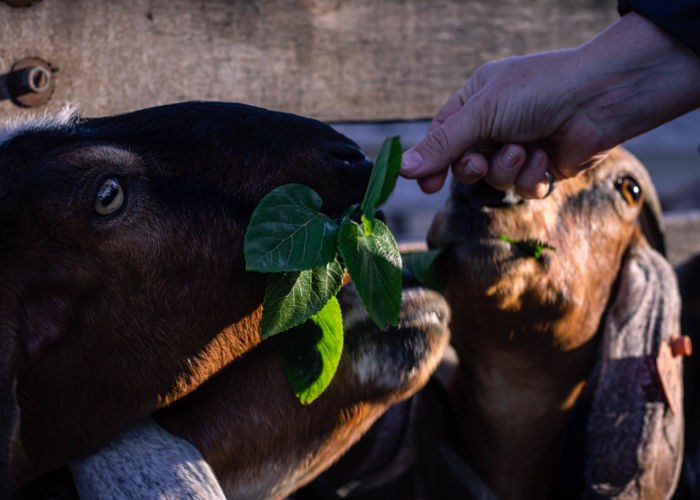
Care Tips for Exotic Goat Breeds
Like any other goats, these exotic goat breeds need TLC despite being hardy.
Since they serve different purposes, their nutritional needs may vary from one another.
But the rule of thumb when feeding goats is 90% high-quality feed and 10% treat.
You also need to provide them with ample shade and access to clean, fresh water, especially during hot summer days.
Goats hate rain and wet weather since they might developpneumoniawhen left out in the rain.
That’s why you must provide a clean, draft-free, and comfortable shelter with enough ventilation.
It doesn’t have to be elaborate; greenhouse barns, calf hutches, and large dog houses will do.
But make sure your goat has enough space, preferably 25 to 50 sq. ft. per goat.
Don’t forget to set up a fence so your goats can’t escape when foraging.
A fence will also protect them from predators and keep them in their place.
The minimum fence height for goats is 4 feet tall, but if you’re raising large exotic goats like Damascus, you need a higher fence.
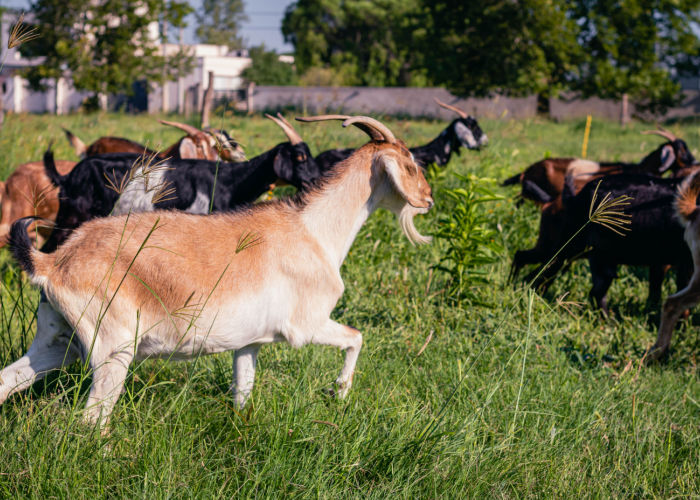
Exotic Goat Breeds: Final Recap
To sum it up, the popular exotic goats in the USA are Saanen, Toggenburg, Anglo-Nubian, Nubian, Boer, Alpine, Angora, Jamnapari Goat, Kahalari Reds, and Damascus goats.
如果你想要一个多产的牛奶生产商考虑甲型肝炎ing exotic breeds of goats for milk production, such as Jamnapari, Anglo-Nubian, Toggenburg, Alpine, and Saanen, because they won’t disappoint you.
On the other hand, Boer and Kahalari Reds are ideal for meat production due to their desirable carcass and tender meat.
If you want multipurpose exotic goats that can provide both, Nubian and Damascus goats are the way to go.
But if you prefer a goat that provides lots of fiber or mohair, we highly recommend Angoras for you.
And that’s a wrap for our exotic goat breed list.
Of all the exotic goat breeds above, which is your favorite?
And if you’re just about to hop onto the homesteading world or goat farming, which goat are you planning to purchase and raise?
Let us know your thoughts in the comment section below.
